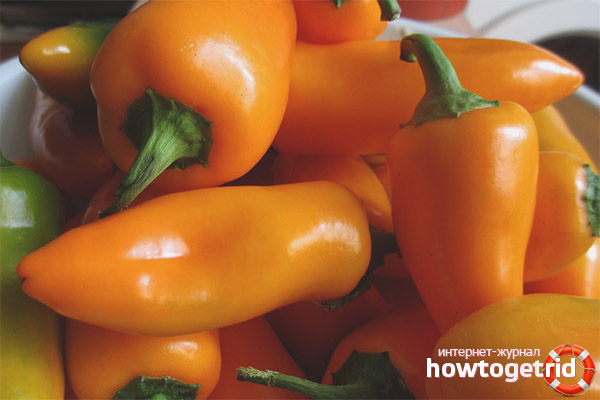The content of the article
This variety of pepper belongs to mid-ripe harvesting varieties. Fruits can be harvested, as a rule, in 110-115 days from the moment of transplanting seedlings in open ground. The plant grows small, with abundant dark green leaf cover. The size of the fruit is average. Pepper Swallow is used for cooking lecho, stuffed, it is also very good at freezing. The advantages of this variety include increased drought tolerance.
Grade characteristics
The fruits of this variety have a conical shape. They are not large, on average, their weight does not exceed 50g. The walls of the pepper are quite fleshy, as it ripens, it acquires a red color and a glossy shade. Also, the fruits may have an orange color.
A feature of this variety is the almost complete absence of seeds. The advantages of the variety include high taste, resistance to most diseases, juiciness of flesh and excellent taste. Chanterelle pepper has a high carotenoid content.
Growing
Before planting seeds, they must be discarded. To do this, they must be filled with a glass of water. Those that pop up can be considered a tank. After it is necessary to conduct the hardening of seeds in a non-concentrated solution of potassium permanganate, this will help to avoid fungal diseases. After the seeds are placed in moist gauze, and after they swell, they are planted in a previously prepared soil mixture. It is advisable to plant the seeds in small peat pots, since the pepper root system slowly develops.
- Growing seedlings on the windowsill, ventilate the seedlings, do not allow waterlogging, do drainage in pots and cups for seedlings. In an apartment, young plants suffer from a lack of sunlight, they stretch out, turn yellow.
- For growing seedlings of bell pepper, chernozem or sandy loam soil is suitable.
- You can get healthy seedlings in peat pots, it takes root painlessly, intensively grows after planting in a greenhouse. The first feeding of seedlings is carried out at the age of 2-3 weeks with complex fertilizers.
- Pepper is a heat-loving culture; it also does not tolerate drafts. At a temperature of 22-24 degrees, the seeds begin to germinate after 7-8 days. Seedlings need additional illumination with special lamps.
- Minus pepper Swallow can be considered not too much productivity. As a rule, with proper care and favorable climatic conditions, up to 2 kg of product can be collected from one bush.
- Pepper is very responsive to organics, so you can actively use herbal infusion, rotted manure or compost.
- Keep this fruit in a cool, dry place. Pepper is well transported over long distances.
- Planting seedlings in open ground or greenhouses is carried out at the end of May. It is necessary to dive the plant after the appearance of a pair of real leaves. Diving is an important procedure that stimulates the development of a fibrous root system.
- Two weeks before planting in the open ground, peppers can be taken outside for several hours.
- When growing pepper in garden plots, you will encounter certain difficulties.One of them is that garden plots are, as a rule, open territories, and wind freely walks along them, which negatively affects the development of pepper. For this reason, for planting this culture, it is worth choosing the most protected places from the wind.
Care
Pepper does not tolerate drought, but also does not favor excess water. Make sure that the earth does not dry out, but do not overdo it with watering. Otherwise, fungal diseases may develop. Watering is carried out directly under the root.
Do not forget about the stepsoning procedure. It will help direct all energy into the fruits, not into the foliage and stepsons. This procedure can be performed no more than seven times every ten days, for one approach you can not remove more than three processes.
Plantations of chanterelle pepper need to be mulched. Use straw or compost as mulch.
Video: chanterelle pepper










Submit